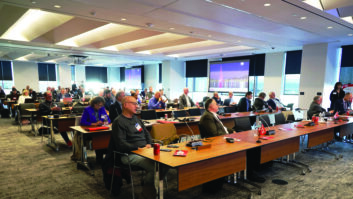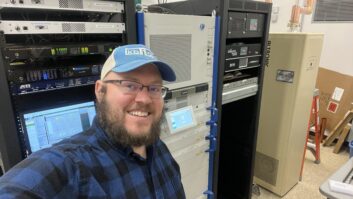Newman-Kees RF Measurements Consultant Frank Hertel recently fell into a conversation with fellow engineers about the FCC-required harmonic and spurious emission specifications for FM.
Several of the engineers mentioned a couple of local 100 Watt ERP LPFMs that didn’t meet the –80 dB requirement for the second harmonic. None of the others said anything to challenge their claims.
Frank writes that he couldn’t help himself and spoke up, saying that 100 Watt ERP LPFMs only need to have harmonics and spurious emissions at a level no greater than –63 dB when referenced to an unmodulated fundamental carrier.
Frank stressed that the reference is an “unmodulated carrier.” This is important. Of course Frank had to prove his statement to everyone.
Here’s the explanation. Typically, everyone touts the –80 dB figure for meeting FCC specs for harmonic and spurious emissions. Although this is the number most of us will use in our day-to-day work, it does not apply until the transmitter system being measured operates at more than ~5,000 Watts of effective radiated power.
Lower-powered transmitter systems that operate at less than this are not required to meet the more commonly used –80 dB requirement. For LPFM stations with a 100 Watt effective radiated power, FM harmonic and spurious emissions are required to be no greater in level than –63 dB. This requirement begins at 600 kHz on either side of the reference carrier frequency.
Here is the simplified FCC formula for all FM stations:
1. Determine the LOG value of the Watts of ERP power for the station.
2. Multiply the above value by 10.
3. Add 43 to this product.
4. The sum of the above math sequence is the implied negative dB value that the emissions must meet. A greater negative dB value is desirable but not required.
Adding to the confusion is that when one measures the harmonics and spurious emissions of a station, it is imperative to know the gain slope of the receiving measuring antenna as well as the losses of the antenna’s connecting cable.
In most cases, an antenna that is 1/10 sub wavelength at the fundamental reference frequency will exhibit a (to be determined) gain, as it measures each increasing harmonic frequency. When directly connected to a sampling port on a transmitter, the accuracy of your measurement will improve, if the content being sampled is identical in level at each frequency that will be measured when compared to the RF content actually being radiated by the transmitting antenna.
Using a direct sampling method hopefully will yield minimal sampling level error and not exhibit any substantial gain, as each increasing harmonic frequency is measured. There is a lot of room for error, even when one tries to get it right. When making any such measurement claims, document everything. Field measurements are, at best, difficult and always subject to one’s best “proof.” That’s why you document.
Interested in details of FM transmission system requirements? Search for section 73.317 of the FCC rules and regulations online.
***
Engineers at AM stations: You may want to check your outside antenna tuning units for rodent infestation at this time of the year. Ditto for any cracks or gaps in the AM or FM transmitter building.

Fig. 1: Copper pot scrubbers work well to plug holes and keep rodents out.
Readers of this column know that expandable foam insulation can be chewed by unwanted guests, so be sure to add copper or stainless steel wool to the plug.
Pictured in Fig. 1, these pot and dish scrubbers can be found at dollar-type and big-box stores for inexpensive prices.
But make sure you don’t buy scrubbers impregnated with soap!
Another caution: Steer clear of steel wool, seen to the left in Fig. 1. Steel wool will rust; the copper or stainless steel will not.
A good method is to plug the hole with stainless steel wool in combination with the spray foam insulation as a sealer. The metal will discourage the pests; the foam insulation helps seal the opening.
***

Fig. 2: Here are two sizes of LED flashlights, available from the big box stores like Home Depot.

Fig. 3: The built-in magnet means these lights are always at hand.
Speaking of big box stores, Brian Oliger and his engineering team at WTOP/Hubbard in Washington call our attention to a couple of LED flashlights from Commercial Electric.
Available at The Home Depot and shown in Fig. 2, it is available in two sizes. Fig. 3 shows an added benefit: the magnet in the end enables the flashlight to mount to any metal surface.
Contribute to Workbench. You’ll help fellow engineers and qualify for SBE recertification credit. Send Workbench tips to [email protected]. Fax to (603) 472-4944.
Author John Bisset has spent 46 years in the broadcasting industry and is still learning. He handles West Coast sales for the Telos Alliance. He is SBE-certified and a past recipient of the SBE’s Educator of the Year Award.












